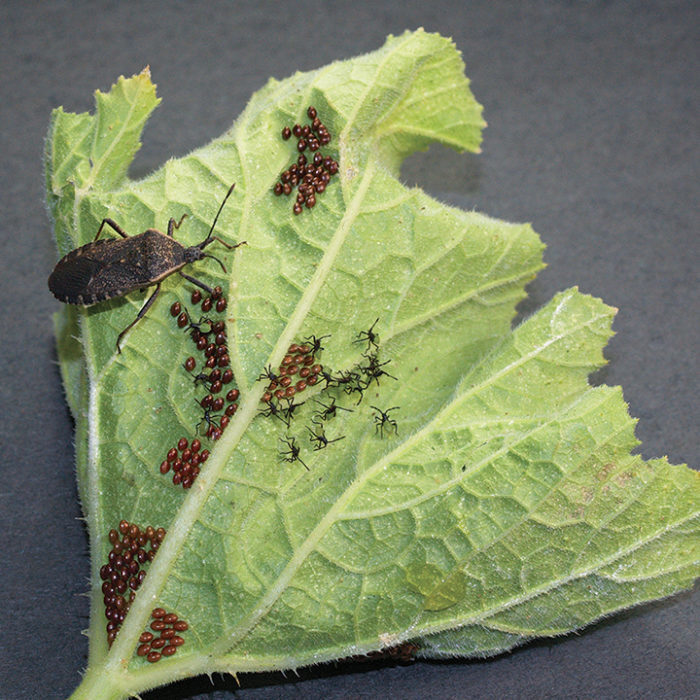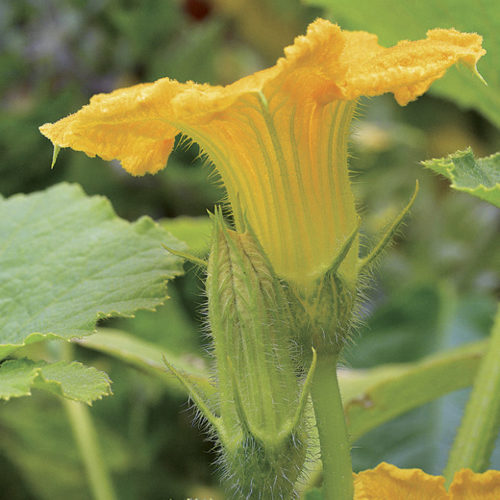How to Grow Great Pumpkins
Whether you grow jack-o’-lanterns or gourmet varieties, all you need is enough time, space, and summer heat

Growing pumpkins can be addictive. My own experience began with growing a few hills of jack-o’-lantern pumpkins in my garden. I now grow over 120 varieties of pumpkins, gourds, and winter squash on about an acre of land, and I am continually amazed by the diversity of this plant family. They grow easily if given a site with good drainage, full sun, adequate water, and fertile soil. If you are thinking of adding pumpkins to your gardening repertoire, here’s what you need to know.
Pumpkins like it warm
Pumpkins are very sensitive to cold soil and frost, so be sure to wait until all danger of frost has passed before planting. Ideally, the soil temperature should be at least 65°F, and nighttime air temperatures should be consistently above 55°F.
Most pumpkins require 90 to 120 days to mature. I harvest in late September, so I typically will plant my seeds in the first week of June. In most zones, the soil temperature should be adequate by then for quick germination.
Pumpkin seeds are large and do well when direct-sown. In regions with a short growing season, seeds can be started indoors. Handle transplants with care, as they are fragile and easily damaged.
Refer to the information provided with your pumpkin seeds to determine spacing, both from hill to hill and between rows. Spacing needs can vary significantly between varieties. Row spacing typically ranges from 6 to 10 feet, and hills are usually spaced at least 3 feet apart.
Fertilize heavily only in the beginning

Pumpkins are heavy feeders and should be fertilized on a regular basis. For early plant growth, use a fertilizer high in nitrogen. Apply it before the vines begin to run, and to provide the nutrients needed for promoting leaf, root and vine growth.
Before the blooming period, switch to a fertilizer higher in phosphorus such as 5-10-5 or 5-15-5. Phosphorus is important for root growth, flowering, and fruit set. After fruit set, supplement plant feeding with extra potassium to further promote fruit growth and health.
It is worth testing your soil to determine how much fertilizer to add. Your goal should be to fertilize just enough to keep plants healthy without contributing to environmental issues.
Pumpkin vines will begin to run and may reach lengths of 15 to 20 feet, depending upon the variety. Vines are relatively fragile and can be damaged by careless treatment. When handled carefully, vines may be moved to maximize available space. Vines can be gently untangled and spread out to provide adequate space for fruit development and to allow leaves to collect the maximum amount of sunlight.
Pumpkin vines will root at the nodes, and these nodes can be covered with soil to promote secondary root growth. The extra roots will help the plant absorb more water and nutrients and anchor the plant to the ground along the entire vine length, providing protection from wind damage.
Thin female flowers to encourage larger fruits
For pumpkins and other cucurbits like melons and cucumbers, the first flowers to appear are usually male. These early male flowers will attract pollinators and help bees establish a pattern of visiting your pumpkin patch.
To tell male and female flowers apart, look at the spot where the stem attaches to the blossom. If the stem is straight, it is a male. If the flower has a small bulb at the base, it is female. To encourage larger fruits, the first two or three female flowers can be removed before fruit set to allow the plants to develop more leaf surface. A single fruit can be allowed to develop, then subsequent female flowers can be picked off after the first fruit has set. This method diverts the plant’s resources to support a single larger fruit rather than several smaller fruits.
Position fruits early for attractive carving pumpkins
Pumpkins develop on the vine in a variety of positions, and may be repositioned to produce fruits that are more attractive for carving. To produce upright pumpkins, those lying on their side may be gently turned to the upright position. Use extreme care or the vine may be damaged or broken, effectively cutting the umbilical cord to the fruit. In some instances, this process may need to be carried out over a few days—better to go “low and slow” than to damage or prematurely cut the vines. If secondary roots have formed at the vine nodes, they may need to be gently loosened to make room for the growing fruit. Throw a shovel-full of soil over the repositioned node to help the plant pick right back up where it left off.
How and when you harvest is important
Most pumpkins, winter squash, and gourds will mature in 90 to 120 days. Most immature fruits are green, ripening to orange, yellow, white, or pink. But color is not the only method to determine that harvest is near. Vines will begin to senesce (age and break down) and will usually twist as they dry out. The shells of ripening fruits also begin to harden, so the fingernail test is a useful tool to determine if the pumpkins are ready to harvest. If you can easily indent the skin of the pumpkin with your fingernail, the fruit is too immature to harvest. Harvesting at this stage will likely result in damaged fruit that will not keep well, so it’s worth waiting a few more days to allow the skin to toughen up.
An intact stem gives a pumpkin a nice appearance and a longer shelf life. When harvesting, cut the stem with pruners or a sharp knife; leave the stem as long as possible—a minimum of 3 to 4 inches. Because a pumpkin will rot quickly if its stem breaks off at the base, always lift with the palms of your hands instead of grabbing the stem. Cure freshly harvested pumpkins in the sun for approximately one week, then store in a cool, dry location.
Hilling helps to warm up the soil
To prepare soil for direct seeding, generations of gardeners have used the following technique to improve drainage and help the soil warm up faster.
1. Use a hoe to make a low hill that is about a foot in diameter and a few inches above the surrounding soil.
2. Tamp with the back of the hoe to firm up the soil.
3. Drop two or three seeds on the hill, cover with ½ to ¾ inch of loose soil, and tamp once more to ensure good seed-to-soil contact.
Full sun
Pumpkins should be grown in an area where they will receive full sun. However, they can tolerate light shade for a few hours a day.

Space
Allow adequate space for pumpkins. Bush varieties can be planted fairly close together, but vining types may require 50 to 100 square feet per hill.
Soil
Pumpkins are heavy feeders, so soils should be fertile and well-drained. Amending soil with compost, manure, or other organic components can be beneficial.
Pest control
Pumpkins are susceptible to damage from a number of insect pests. The big three are cucumber beetles, squash bugs, and squash vine borers. Scout for these pests two or three times per week, and take appropriate action if you spot any. In addition to feeding on plants, insects can serve as a vector for some devastating plant diseases if not controlled.
Our Favorite Pumpkin Varieties to Grow at Home
These favorites offer outstanding colors, shapes, and flavors.
‘Marina di Chioggia’Days to maturity: 100 Fruit size: 6 to 12 lb. Average fruits per plant: 2 This Italian heirloom is both flavorful and decorative, providing contrast for fall displays that are mostly orange, yellow, or white. |
‘Moonshine’Days to maturity: 100 Fruit size: 8 to 12 lb. Average fruits per plant: 3 to 4 This smooth-skinned, white pumpkin has thick, yellow flesh and a long green stem. |
‘Rouge Vif D’Etampes’Days to maturity: 115 Fruit size: 10 to 15 lb. Average fruits per plant: 2 The bright orange-red “Cinderella-type” variety features a flattened shape and shallow ribs. |
‘Prizewinner’Days to maturity: 120 Fruit size: Up to 150 lb. Average fruits per plant: 1 This is the best giant pumpkin, with deep, bright color, shallow ribs, and a true pumpkin shape. |
‘Hooligan’Days to maturity: 90 Fruit size: ¾ lb. Average fruits per plant: 6 to 7 This sweetly mottled mini-pumpkin is the perfect size for stuffing. |
‘Champion’Days to maturity: 90 Fruit size: 30 to 40 lb. Average fruits per plant: 1 to 2 This large, well-ribbed jack-o’-lantern pumpkin matures early. |
‘Winter Luxury’Days to maturity: 105 Fruit size: 5 to 7 lb. Average fruits per plant: 3 to 4 Tops for eating, this variety’s netted skin is similar to that of a cantaloupe. |
‘Jarrahdale’Days to maturity: 100 Fruit size: 12 to 18 lb. Average fruits per plant: 2 to 4 Sweet orange flesh hides under the deeply ribbed, slate-blue skin. |
‘Autumn Colors Cushaw’Days to maturity: 105 Fruit size: 4 to 10 lb. Average fruits per plant: 2 to 3 This tricolored variety is treasured for its outstanding flavor and visual appeal. |
‘Baby Bear’Days to maturity: 105 Fruit size: 1½ to 2½ lb. Average fruits per plant: 8 A small pumpkin with smooth skin that’s perfect for painting, it is a great size for kids to handle. |
‘Racer’Days to maturity: 85 Fruit size: 12 to 16 lb. Average fruits per plant: 2 to 3 The small, short-season jack-o’-lantern pumpkin grows on a short, vigorous vine. |
Variety photos, except where noted: courtesy of Johnny’s Selected Seeds. Photo of ‘Prizewinner’: Carol Collins.
Blake Brown is director of the University of Tennessee’s AgResearch and Education Center at Milan.
Photos, except where noted: Carol Collins
Sources
- Baker Creek Heirloom Seeds, Mansfield, MO; 417-924-8917; rareseeds.com
- Johnny’s Selected Seeds, Winslow, ME; 877-564-6697; johnnyseeds.com
- W. Atlee Burpee & Co., Warminster, PA; 800-888-1447; burpee.com
Fine Gardening Recommended Products

Corona E-Grip Trowel
Fine Gardening receives a commission for items purchased through links on this site, including Amazon Associates and other affiliate advertising programs.

The New Organic Grower, 3rd Edition: A Master's Manual of Tools and Techniques for the Home and Market Gardener, 30th Anniversary Edition
Fine Gardening receives a commission for items purchased through links on this site, including Amazon Associates and other affiliate advertising programs.




















Comments
Log in or create an account to post a comment.
Sign up Log in